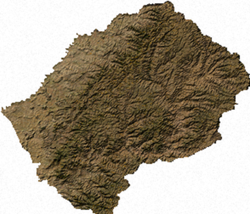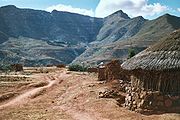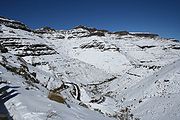
Geography of Lesotho
Background to the schools Wikipedia
SOS Children, an education charity, organised this selection. All children available for child sponsorship from SOS Children are looked after in a family home by the charity. Read more...
Coordinates: 29°30′S 28°30′E
| Geography of Lesotho | |
|---|---|
 |
|
| Continent | Africa |
| Region | Southern Africa |
| Coordinates | 29°30'S 28°30'E |
| Area | Ranked 141st 30,355 km2 (11,720 sq mi) 100% land 0 % water |
| Borders | Total land borders: 909 km (565 mi) South Africa: 909 km (565 mi) |
| Highest point | Thabana Ntlenyana 3,482 m (11,424 ft) |
| Lowest point | Junction of the Orange and Makhaleng Rivers 1,400 m (4,593.2 ft) |
Lesotho is a mountainous, landlocked country located in Southern Africa. It is an enclave, completely surrounded by South Africa. The total length of the country's borders is 909 kilometres (565 mi). Lesotho covers an area of around 30,355 square kilometres (11,720 sq mi), of which a negligible percentage is covered with water.
The most notable geographic fact about Lesotho, apart from its status as an enclave, is that it is the only independent state in the world that lies entirely above 1,000 metres (3,281 ft) in elevation. Its lowest point is at 1,400 metres (4,593 ft), the highest lowest point of any country. Because of its elevation, the country's climate is cooler than in most other regions at the same latitude. Its climate zone can be classified as continental.
Location
Lesotho is a country in Southern Africa, located at around 29°30' south latitude and 28°30' east longitude. It is the 141st largest country in the world, with a total land area of 30,355 square kilometres (11,720 sq mi), of which a negligible percentage is covered with water. Lesotho is completely surrounded by South Africa, making it one of only three countries in the world that are enclaves within another country; the other two are San Marino and Vatican City, both located within Italy. The total length of the South African border is 909 kilometres (565 mi). Lesotho's status as an enclave also means that it is landlocked and largely dependent on South Africa. The nearest major shipping port is Durban.
Physical geography
Lesotho can be roughly divided into three geographic regions: the lowlands, following the southern banks of the Caledon River, and in the Senqu river valley; the highlands formed by the Drakensberg and Maloti mountain ranges in the east and central parts of the country; and the foothills that form a divide between the lowlands and the highlands. The lowest elevation in the country is at the junction of the Makhaleng and Orange (Senqu) rivers (at the South African border), which at 1,400 metres (4,593 ft) is the highest lowest point of any country. Lesotho is the only independent state in the world that lies entirely above 1,000 metres (3,281 ft) in elevation. The highest point is the peak of the Thabana Ntlenyana mountain, which reaches an elevation of 3,482 metres (11,424 ft). Over 80% of Lesotho lies above 1,800 metres (5,906 ft).
Even though very little of Lesotho is covered in water, the rivers that run across the country are an important part of Lesotho's economy. Much of the country's export income comes from water, and much of its power comes from hydroelectricity. The Orange River rises in the Drakensberg mountains in northeastern Lesotho and flows across the entire length of the country before exiting to South Africa at the Mohale's Hoek District in the southwest. The Caledon River marks the northwestern part of the border with South Africa. Other rivers include the Malibamatso, Matsoku and Senqunyane.
The bedrock of Lesotho belongs to the Karoo Supergroup, consisting mostly of shale and sandstone. Peatlands can be found in the highlands of Lesotho, most extensively in the mountainous escarpment near the country's eastern border. The summit of Thabana Ntlenyana is partially encircled by bogs.
Political geography
Lesotho is divided into 10 administrative districts, each with its own capital, called a camptown. The districts are further subdivided into 80 constituencies, which consist of 129 local community councils.
Districts (in alphabetical order):
- Berea
- Butha-Buthe
- Leribe
- Mafeteng
- Maseru
- Mohale's Hoek
- Mokhotlong
- Qacha's Nek
- Quthing
- Thaba-Tseka
Climate
Because of its altitude, the country remains cooler throughout the year than most other regions at the same latitude. Lesotho has a continental climate, with hot summers and cold winters. Maseru and its surrounding lowlands often reach 30 °C (86 °F) in the summer. Winters can be cold with the lowlands getting down to −7 °C (19.4 °F) and the highlands to −18 °C (−0.4 °F) at times.
The yearly precipitation varies from around 600 millimetres (23.6 in) in the lowland valleys to around 1,200 millimetres (47.2 in) in areas of the northern and eastern escarpment bordering South Africa. Most of the rain falls as summer thunderstorms: 85% of the annual precipitation falls between the months of October and April. The winters—between May and September—are usually relatively dry. Snow is common in the deserts and low valleys between May and September; the higher peaks can experience snowfall year-round. There is much yearly variance in the amounts of rainfall, which leads to periodic droughts.



